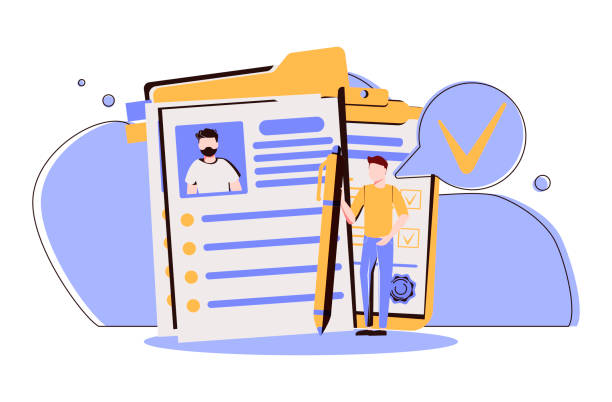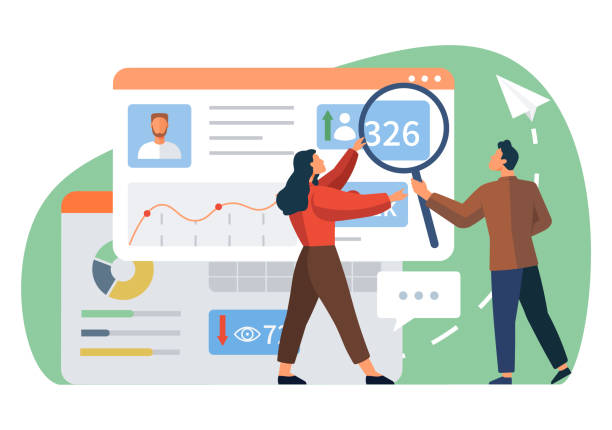The Fundamental Importance of Secure Website Design in the Current Era

In today’s rapidly expanding digital world, secure website design is no longer an option, but a vital necessity.
Today, every website, whether a large commercial platform or a personal blog, is potentially a target for cyberattacks.
#Cybersecurity and #User_Data_Protection form the backbone of trust in the online space.
This not only includes protecting sensitive customer data but also ensures the stability and credibility of your business.
Ignoring the principles of secure website design can lead to data loss, damage to brand reputation, legal penalties, and even bankruptcy.
A successful cyberattack can have devastating consequences, including user privacy breaches and misuse of financial information.
In this regard, a deep understanding of existing threats and the application of preventive strategies in the early stages of website design and development are of paramount importance.
This explanatory chapter shows you why investing in website security from the outset is the smartest decision you can make.
In fact, a proactive approach to application security and web infrastructure is far more effective and cost-efficient than reacting after an attack has occurred.
The responsibility for creating a secure website lies with developers and web administrators to provide a trustworthy environment for users.
This is not just a technical discussion, but also an ethical and business one.
Is your company’s website as professional and trustworthy as it should be? With specialized corporate website design by Rasaweb, create an online presence that reflects your credibility and attracts more customers.
✅ Build a powerful and professional image for your brand
✅ Convert visitors into real customers
⚡ Get a free consultation now!
Understanding the Most Common Web Security Threats

To succeed in secure website design, one must first know the enemies.
#Cyber_attacks and #Data_breaches are among the major challenges that threaten websites daily.
In this educational section, we examine the most common threats that can jeopardize your website security.
One of the most common attacks is SQL Injection, where attackers gain access to sensitive information by injecting malicious code into the database.
Another attack is called Cross-Site Scripting (XSS), in which malicious code is executed client-side and can lead to the theft of cookies or user information.
DDoS (Distributed Denial of Service) attacks render websites unavailable by sending a massive volume of traffic to the server.
Also, Broken Authentication and Insecure Session Management vulnerabilities provide ways for unauthorized access to user accounts.
Secure website design requires understanding these vulnerabilities and adopting preventive measures.
Phishing and social engineering are also common methods that, although not directly related to website code, can deceive users and steal their information.
Staying up-to-date with the latest news and reports on security threats is an integral part of the website security strategy.
By precisely understanding these threats, we can properly shape our defenses and adopt a comprehensive approach to secure website design.
Best Practices for Secure Coding and Vulnerability Prevention

One of the main pillars of secure website design is adherence to #secure_coding.
In this specialized section, we examine the details and methods that developers can use to write attack-resistant code.
Using precise Input Validation for all user input data is crucial to prevent attacks like SQL Injection and XSS.
Also, using Prepared Statements and ORMs for database interaction is an effective way to prevent SQL injection.
The “Principle of Least Privilege” should always be observed, meaning that each part of the code or user only needs the minimum necessary access to perform its task.
In website error management, avoid disclosing sensitive information in error messages and instead provide more general and user-friendly messages.
Secure website design requires attention to detail.
For example, all passwords should be stored as hashed and salted and never kept as plain text.
Using secure web development frameworks like Laravel, Django, and Ruby on Rails, which have built-in security mechanisms, can significantly contribute to website security.
Next, a table of common vulnerabilities and their corresponding coding solutions is provided:
| Vulnerability Type | Description | Coding Solution |
|---|---|---|
| SQL Injection | Unauthorized database access or modification | Use of Prepared Statements, input validation |
| Cross-Site Scripting (XSS) | Injection of malicious scripts client-side | Proper escaping of data, Content Security Policy (CSP) |
| Broken Authentication | Weak authentication or flaw in session management | Strong password, multi-factor authentication, secure session management |
By continuously practicing and applying these principles, significant steps can be taken towards securing the website.
Database Security: The Backbone of Information Protection

The database is the heart of every website and contains the most valuable information, including user data, transactions, and content.
#Database_Security and #Data_Protection are considered the most vital parts of secure website design.
This section, presented as a guide, focuses on key methods for securing the database.
The first step is to apply the principle of least privilege in database access.
This means that each user or service should only have access to the information essential for its operation.
Encrypting sensitive data, whether at rest or in transit, is of paramount importance.
For this purpose, using secure protocols like TLS for database communication is recommended.
Regular and secure database backups are a vital strategy for rapid recovery in case of attacks or system failures.
These backups should be stored in secure locations, preferably separate from the main server.
Furthermore, Database Management Systems (DBMS) should be continuously updated to address known security vulnerabilities.
Secure configuration of the database server, including disabling unnecessary ports and services, is also highly important.
Secure website design will be incomplete without attention to these details at the database level.
Limiting the number of login attempts (Brute-Force Protection) and implementing Intrusion Detection Systems (IDS) can also help identify and prevent attacks.
In summary, securing the database goes beyond just correct coding and requires a comprehensive approach including configuration, encryption, backup, and access management.
Is your e-commerce site ready to attract maximum customers and increase sales? Rasaweb revolutionizes your online business with modern and efficient e-commerce website design.
✅ Increased speed and SEO improvement
✅ Excellent user experience on mobile and desktop⚡ Get a free e-commerce website design consultation from Rasaweb!
How to Strengthen Authentication and Authorizations on Your Website

One of the thought-provoking content questions in secure website design is how can we ensure that only authorized individuals have access to information and what operations they can perform? #Authentication and #Authorization are two fundamental concepts in web security that have subtle differences but complement each other.
Authentication means verifying the user’s identity (e.g., with a username and password), while authorization determines what resources a user can access and what actions they can perform after authentication.
To strengthen authentication, the use of Two-Factor Authentication (2FA) or Multi-Factor Authentication (MFA) is highly recommended.
These methods create additional security layers, even if the user’s password is compromised.
Password management should include mandating strong passwords, storing hashed passwords with salt, and implementing periodic password change policies.
Secure website design also includes implementing anti-Brute-Force attack mechanisms such as account locking after multiple unsuccessful login attempts.
In the authorization section, Role-Based Access Control (RBAC) should be used.
This means defining different roles (e.g., administrator, editor, regular user) and assigning specific permissions to each role.
Never trust user input for determining permissions. Always verify permissions on the server-side (backend).
Overall, securing a website in this section means high precision in identity verification and logically and securely restricting access.
The Critical Role of SSL/TLS and Encryption in Secure Web Communications

In any secure website design strategy, SSL/TLS plays a pivotal role.
These protocols are the backbone of #secure_communications on the internet and ensure that data exchanged between the user and the server remains #encrypted and confidential.
This explanatory section clarifies the importance of SSL/TLS certificates and how they work.
When a website uses HTTPS (the secure version of HTTP), it means that its communications are encrypted by SSL/TLS.
This prevents attackers from intercepting and reading sensitive data such as credit card information or passwords during transmission.
Proper installation and configuration of an SSL/TLS certificate is essential for any website that exchanges sensitive information.
Also, ensuring the certificate is up-to-date and using strong and current TLS versions (such as TLS 1.2 or TLS 1.3) is highly important.
SSL/TLS certificates are issued by Certificate Authorities (CAs) and come in various types, from Domain Validated (DV) certificates to Extended Validation (EV) certificates, which offer a higher level of trust.
Secure website design is inconceivable without HTTPS and strong encryption.
This not only builds user trust but also helps improve SEO (Search Engine Optimization) for the website, as search engines prefer secure websites.
Encrypting communication alone is not enough; it must be ensured that all resources (such as images, scripts, and CSS) are also loaded via HTTPS to prevent Mixed Content errors.
Server and Infrastructure Security: Maintaining a Secure Website

In the discussion of secure website design, focusing solely on coding is not enough; #server_security and #infrastructure are also of vital importance.
This specialized section addresses security aspects beyond the website code and provides guidelines for securing the hosting environment.
Secure server configuration, including a strong Firewall and precise access rules, is the first line of defense.
All unnecessary ports should be closed, and only services required for website operation should be active.
Regular updates of the server operating system, web software (such as Apache or Nginx), and programming languages (such as PHP or Python) are crucial for patching known vulnerabilities.
Using Intrusion Detection Systems (IDS) and Intrusion Prevention Systems (IPS) can help identify and block suspicious activities.
Server hardening also includes continuous Log Monitoring to detect suspicious patterns and intrusion attempts.
Secure website design means creating a comprehensive security ecosystem that includes not only code but also the server and network.
Next, a table of server security checklist for maintaining website security is provided:
| Security Item | Description | Importance |
|---|---|---|
| Firewall configuration | Filtering inbound and outbound traffic | Critical |
| Software updates | Patching known vulnerabilities | Very High |
| Log Management | Monitoring suspicious activities | High |
| SSH/RDP Security | Using strong keys, disabling password login | Very High |
With these measures, your website infrastructure can achieve greater stability and security.
The Importance of Security Audits and Regular Updates

In the ever-changing world of #cyber_threats, secure website design is not a one-time event, but a continuous process.
This section, presented as news and a guide, emphasizes the importance of regular security audits and continuous updates.
No website is completely immune to attacks, and with the discovery of new vulnerabilities or the release of security patches, there is a constant need for review and updates.
Security Audits and Penetration Tests should be performed regularly to identify and resolve potential weaknesses in code, server configuration, or business logic.
These tests can include automated vulnerability scanning as well as manual testing by security experts.
Furthermore, continuous updating of all software used, from operating systems and databases to web frameworks and plugins, is essential.
Many successful attacks occur due to the untimely updating of software with known vulnerabilities.
Follow the latest cybersecurity news and reports to stay informed about the latest threats and solutions.
Be careful not to use insecure or unreliable third-party plugins and themes, as these can be gateways for intrusion.
Securing a website requires a proactive and vigilant approach.
Development teams should be trained on secure website design principles, and a security culture should be institutionalized within the organization.
Research shows that 80% of customers trust companies with a professional website more. Does your current site inspire this trust?
With Rasaweb’s corporate website design services, permanently solve the problem of customer distrust and a weak online image!
✅ Create a professional image and increase customer trust
✅ Attract more sales leads and business growth
⚡ Get a free consultation
Security Incident Management and Disaster Recovery Plan

Even with the most meticulous secure website design, the probability of a security incident is still not zero.
#Cyber_Incident_Management and #Disaster_Recovery are vital aspects of web security that are often overlooked.
This analytical section helps you prepare for worst-case scenarios.
Having a well-documented Incident Response Plan is crucial.
This plan should include specific steps for Identification, Containment, Eradication, Recovery, and Lessons Learned.
The main goal is to minimize damage and quickly return to normal operation.
Security teams should periodically practice these plans to act quickly and efficiently during a crisis.
In addition, a Disaster Recovery Plan (DRP) must be in place to ensure website and data availability in the event of larger disasters (such as server failure, natural disasters, or widespread attacks).
Investing in advanced monitoring tools, capable of detecting anomalies and security alerts, can significantly reduce incident response time.
Secure website design includes not only prevention but also preparedness for response and recovery.
Transparency with users after a security incident, while observing privacy considerations, can help maintain trust.
Finally, every security incident, no matter how small, is an opportunity to learn and further strengthen the defenses of a secure website.
A Look at the Future of Web Security and New Trends

The world of secure website design is constantly evolving.
#Future_security_trends and #new_technologies are constantly emerging.
This entertaining and analytical section provides a look at the future horizons of web security and what we can expect.
With the growth of Artificial Intelligence (AI) and Machine Learning (ML), we will witness the emergence of more advanced security solutions for threat detection and response.
These technologies can identify attack patterns faster and automatically activate defensive measures.
Cloud Security will also gain increasing importance as more businesses migrate to cloud platforms.
Securing data and applications in cloud environments requires its own specific approaches.
Passwordless Authentication using biometrics or hardware security keys promises a more secure and convenient future for users.
These methods can eliminate many weaknesses associated with traditional passwords.
Secure website design will increasingly move towards Microservices and API-First architectures in the future.
These architectures pose new security challenges but also provide opportunities for better isolation and zero-trust security.
Securing a website is an endless journey, but by being aware of new trends and embracing emerging technologies, we can take a big step towards a safer digital world.
Always be curious and look for creative ways to protect your website.
Frequently Asked Questions
| Question | Answer |
|---|---|
| What is secure website design? | Secure website design is a process in which websites are built considering security principles to be resistant to cyberattacks and to protect user and business information. |
| Why is secure website design of high importance? | To prevent unauthorized data access, sensitive information leaks, malware attacks, loss of user trust, damage to business reputation, and legal consequences arising from data breaches. |
| What are the most common website vulnerabilities? | SQL Injection, Cross-Site Scripting (XSS), Cross-Site Request Forgery (CSRF), Broken Authentication and Session Management, and sensitive information disclosure. |
| How can SQL Injection attacks be prevented? | Using Prepared Statements with Parameterized Queries, Input Validation, and restricting database access. |
| What are the methods to counter XSS (Cross-Site Scripting) attacks? | User Input Validation, Output Encoding before displaying in HTML, and using Content Security Policy (CSP). |
| What is the role of HTTPS in website security? | HTTPS encrypts the communication between the user’s browser and the website server using an SSL/TLS certificate, preventing eavesdropping, tampering, or forging of data. |
| What are the best methods for managing user passwords? | Enforcing strong passwords (a combination of letters, numbers, and symbols), hashing passwords instead of storing them directly (with strong algorithms like bcrypt), and enabling Two-Factor Authentication (2FA). |
| What is the importance of User Input Validation? | Input validation prevents malicious or unexpected data from entering the system, which could lead to vulnerabilities like SQL Injection or XSS. |
| What impact do security reviews and regular audits have on site security? | These reviews help identify vulnerabilities and security weaknesses early on and allow them to be fixed before they can be exploited. |
| What is the use of Web Application Firewall (WAF) in secure website design? | A WAF acts as a protective layer between the user and the website, analyzing incoming traffic, identifying, and blocking common web attacks like SQL Injection and XSS. |
And other services of Rasaweb Advertising Agency in the field of advertising
Digital Branding Intelligent: A professional solution for analyzing customer behavior with a focus on SEO-driven content strategy.
Smart Reportage: A fast and efficient solution for campaign management focusing on custom programming.
Smart Marketplace: Revolutionize click-through rates with custom programming.
Smart Advertising Campaign: A fast and efficient solution for user engagement focusing on intelligent data analysis.
Smart Direct Marketing: Revolutionize click-through rates with Google Ads management.
And over hundreds of other services in internet advertising, advertising consultation, and organizational solutions
Internet Advertising | Advertising Strategy | Advertorials
Resources
Website Security
Comprehensive Web Security Guide
Increasing Website Security
Secure Website Design
? Rasaweb Afarin is your strategic partner in the fast-paced digital world. With a targeted and professional approach, we help businesses achieve a powerful and impactful online presence and reach their marketing goals.
If you are looking to grow your business and create a lasting digital identity, Rasaweb Afarin’s expert team, by providing modern and optimized corporate website design services, paves your way to success. For consultation and more information, contact us.
📍 Tehran, Mirdamad Street, next to Bank Markazi, Kazeroon Janoubi Alley, Ramin Alley, No. 6



